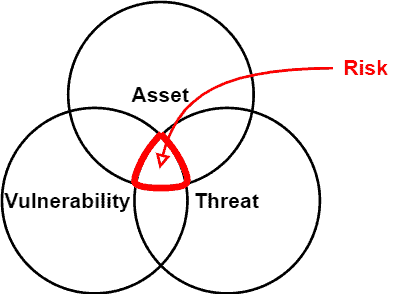1. 简介
在日常生活中,我们经常能接触到“威胁”(Threat)、“漏洞”(Vulnerability)和“风险”(Risk)这些概念。比如在现实世界中,恶意人员、危险动物、基础设施问题都可以被视为威胁;而注意力不集中、出门忘记锁门等行为,则是漏洞;威胁与漏洞的结合就可能引发风险,例如被盗或受伤。
这些概念在数字世界中同样适用,而且有着更明确的定义和影响。
本文将深入探讨威胁、漏洞和风险在计算机系统中的表现形式。我们会先介绍这些概念为何在数字世界中存在,并明确“资产”(Asset)的含义。随后分别定义威胁、漏洞和风险,并探讨它们之间的关系。最后,我们会给出一些防护建议,并进行系统性的总结。
2. 数字威胁、漏洞与风险的动因
过去几十年,计算机技术已成为人类生活的核心。随着网络的普及,人们可以跨越地理限制高效地交流和传输数据,使得数字世界愈发重要。
计算机程序承担了越来越多敏感任务的处理,如银行交易、地理位置数据、医疗记录等。这些数据和处理流程本身已成为拥有者的重要资产。
在本文中,“资产”指的是对拥有者有价值的任何事物。而“数字资产”则是以数字形式存储或处理的有价值数据或流程。
数字资产的存在,也带来了数字威胁。这些威胁往往通过利用漏洞来达成目的,从而形成数字风险。
接下来我们分别来看威胁、漏洞和风险的具体定义及其关系。
3. 威胁(Threat)
在计算机领域,威胁指的是可能导致系统发生不良后果的任何行为或事件,通常依赖于某个漏洞来实现其目的。
威胁主要分为两类:
✅ 有意威胁(Intentional Threats):由恶意实体(人或程序)发起,目的明确,如:
- 黑客攻击(如钓鱼攻击 phishing、SQL 注入、拒绝服务攻击 DoS/DDoS)
- 恶意软件(Malware):如病毒、蠕虫、木马、广告软件(Adware)
✅ 无意威胁(Non-intentional Threats):非人为故意造成的问题,例如:
- 因自然灾害导致网络中断
- 硬件故障或人为操作失误
这类威胁虽无恶意,但仍可能造成严重后果。
4. 漏洞(Vulnerability)
漏洞是指计算系统中的任何弱点,或安全机制的不足之处。威胁往往利用这些漏洞达成攻击目的,从而形成“攻击入口”(Exploit)。
漏洞的产生原因包括:
- ✅ 复杂性:系统越复杂,越难全面保障安全性
- ✅ 联网性:系统与外部通信越多,越容易暴露漏洞
- ✅ 维护不足:未及时更新补丁或使用过时软件
按影响层面,漏洞可分为:
| 类型 | 说明 |
|---|---|
| 硬件 | 如设备老化、环境恶劣、物理损坏 |
| 软件 | 编码不安全、测试不充分、设计缺陷 |
| 网络 | 使用明文协议、架构设计不合理 |
| 人员 | 安全意识不足、操作不当、权限管理混乱 |
⚠️ 注意:减少漏洞数量是降低风险的核心手段之一。
5. 风险(Risk)
风险可以理解为:当某个威胁利用系统中的漏洞,导致资产受损的可能性。例如数据泄露、服务中断、系统被控制等。
风险由三个要素共同构成:
- 资产(Asset)
- 漏洞(Vulnerability)
- 威胁(Threat)
下图展示了三者之间的关系:

⚠️ 注意:处于风险中并不等于正在被攻击。系统可能长期处于风险状态但未发生实际损失,但这并不意味着安全。
6. 防护措施(Protective Measures)
要降低风险,关键在于消除或减少三要素之一。通常资产是必须存在的,威胁也无法完全消除,因此最有效的做法是:
✅ 减少漏洞数量,例如:
- 定期更新系统和软件
- 使用防火墙、杀毒软件等安全工具
- 仅安装可审计或来源可信的软件
- 使用漏洞扫描工具定期检查系统
⚠️ 注意:漏洞扫描工具可能会报告大量“误报”,需结合人工判断使用。
7. 系统化总结(Systematic Summary)
现代计算系统中的数据和服务已成为重要资产。这些资产吸引了恶意实体的注意,形成了数字威胁。而威胁往往通过系统中的漏洞来实现攻击目标,从而构成风险。
三者关系总结如下表:
| 项目 | 威胁(Threat) | 漏洞(Vulnerability) | 风险(Risk) |
|---|---|---|---|
| 核心定义 | 有意或无意影响资产的行为 | 系统的安全弱点 | 威胁利用漏洞造成的潜在问题 |
| 相互关系 | 利用特定漏洞 | 可独立存在 | 依赖资产、威胁和漏洞共同存在 |
| 示例 | 恶意软件、广告软件、意外事件 | 软件过时、配置错误 | 数据泄露、系统被僵尸化 |
8. 总结
在本篇文章中,我们详细探讨了威胁、漏洞与风险三者的定义、区别及其相互关系。
- 威胁无处不在,包括有意和无意的行为
- 漏洞是系统中的弱点,是威胁得以实现的手段
- 风险是三者结合后的潜在后果
在数字世界中,资产的存在使得威胁和漏洞的组合成为风险的来源。虽然我们无法彻底消除威胁,但通过识别并修复漏洞,可以显著降低风险发生的概率。
作为系统运维或安全人员,我们的职责是:
✅ 定期检查系统
✅ 及时修补漏洞
✅ 部署合理防护机制
这样才能在威胁面前,最大程度地保护我们的数字资产。